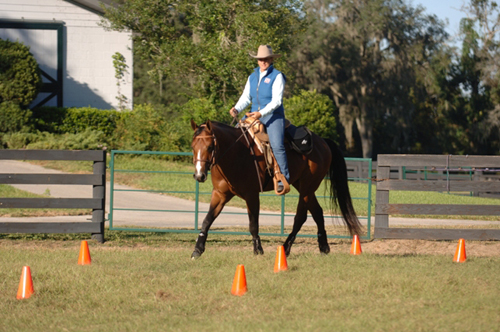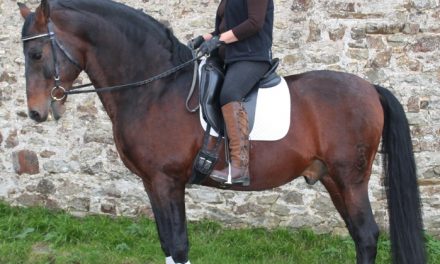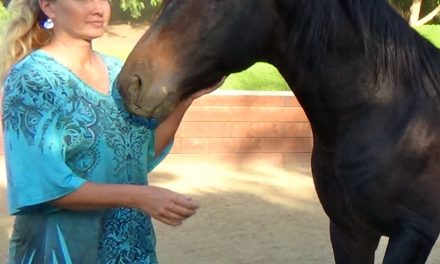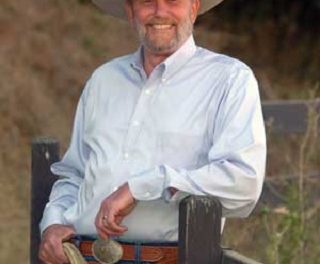Palm Partnership Training
 Dressage education is based on a scale of training where a solid foundation is laid down and then added to as the horse progresses. The image of a pyramid is aptly used for this scale with rhythm as the base and collection at the top. For our purposes, we will discuss each layer of the pyramid in order. It is imperative that novice riders thoroughly understand each layer of the pyramid and learn them in order. However, as discussed in a recent USDF Connection magazine article “Outside the Pyramid,” not all horses learn in the same manner, so advanced riders should use the scale as a guideline and not as an inflexible training method.
Dressage education is based on a scale of training where a solid foundation is laid down and then added to as the horse progresses. The image of a pyramid is aptly used for this scale with rhythm as the base and collection at the top. For our purposes, we will discuss each layer of the pyramid in order. It is imperative that novice riders thoroughly understand each layer of the pyramid and learn them in order. However, as discussed in a recent USDF Connection magazine article “Outside the Pyramid,” not all horses learn in the same manner, so advanced riders should use the scale as a guideline and not as an inflexible training method.
In each article we will discuss one layer of the pyramid. The term will be defined and explained and I will give you exercises to use to help your horse to achieve that concept. When I have explained all the steps of the pyramid within a dressage level, I then will discuss a dressage test in relationship to them.
Rhythm and Regularity
As mentioned above, the base of the dressage pyramid is rhythm, but it also includes regularity. The USDF Glossary of Dressage Judging Terms defines the two terms as follows: Rhythm is the characteristic sequence of footfalls and phases of a given gait. For the purposes of dressage, the only correct rhythms are those of the pure walk, pure trot, and pure canter. Not to be confused with tempo (rate of repetition of footfalls, or speed). Regularity is correctness of the gait, to include purity, evenness, and levelness. Irregularities may be momentary or pervasive, and they may or may not be caused by unsoundness. Rhythm and regularity must be maintained on straight lines, bending lines, lateral work, and transitions.
Beginning Your Dressage Training
As with any sport, it is important to start your dressage training under the guidance of a trained professional. The initial phase of any sport sets the foundation for what is to come and it is far better to start off correctly rather than start with bad habits that have to be corrected later on.
Having said that, however, there are exercises you can do on your own at home to strengthen your horse and to improve your riding skills. Because the trot is the gait that is the most naturally balanced, we will use the posting trot for our first exercise.
As you learn these dressage lessons, remember that they are designed for riders and horses in any discipline and not just for the serious dressage rider. In his book, Dressage for Beginners¸ R.L.V. French Blake says that, “The first three stages (Training Level and Levels 1-2) contain the basic requirements of schooling for every form of riding horse, whatever the purpose for which it is to be used;…”
The Arena
Before we can begin our exercise, you need to understand the dressage arena. A picture is definitely worth a thousand words here, and you can go to www.ridinghabit.com/guide/geometry/arenas.htmlfor diagrams of both the large and the small arenas. The small arena is a rectangle, 40 x 20 meters (44 x 22 yards). The large arena is 60 x 20 meters (66 x 22 yards). The middle of both arenas is “X.” The letters you see on the arena are there as guides for movements.
You can set up an arena in your riding area using things you have around your barn and yard. Large-diameter PVC pipe works well as do poles or even old fence posts and boards painted white for visibility. Just be sure that whatever you use does not have any sharp edges that could hurt your horse. The entire outline of the arena does not need to be marked, but it is good to have sections of whatever you use where the letters are placed.
You also can make your own letters. Large plastic jugs filled with sand and painted with black letters work well. Use your imagination. Again, make sure you use objects that are safe for you and your horse if you should come in contact with them.
Riding the Corners of the Arena
If you are used to riding in an open area or in a round arena, the first thing you will notice about the dressage arena is that it has square corners. Don’t let this throw you as you will ride the corners as a quarter circle. You will need to use both the turning and bending aids to ride the corners. You should only ride as deep into the corners as your horse can go without losing the rhythm. This may seem like an easy exercise, but riding the corners is a great way to help you learn to feel the correct rhythm. It also is preparation for riding a complete circle—an exercise I will go over in the next article.
While you are doing the exercises to strengthen your horse, always be conscious of your rider position. Your position and balance will affect your horse’s balance and rhythm. You will be able to give your horse clear cues and control the coordination of your aids only if you are balanced. The great discipline of dressage teaches you to ride with precision.
For more information about training courses, educational materials and more, please visit www.lynnpalm.com or call 800 503-2824





